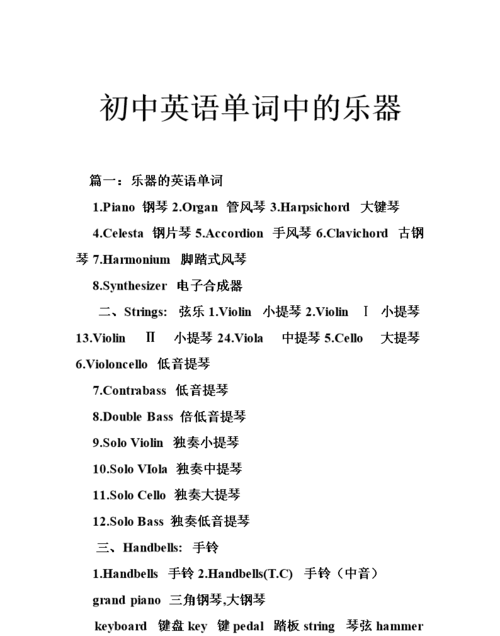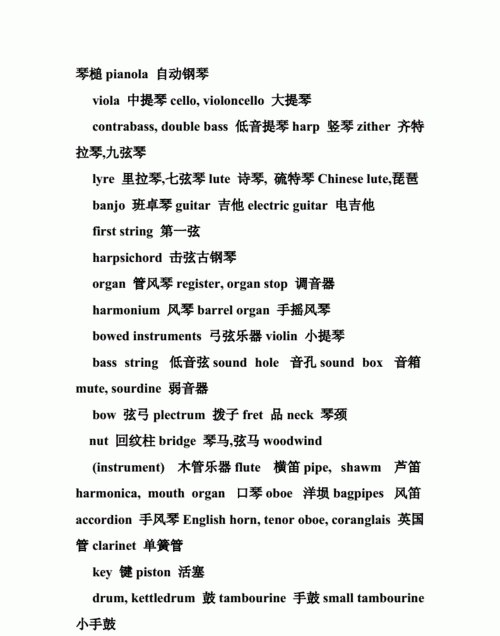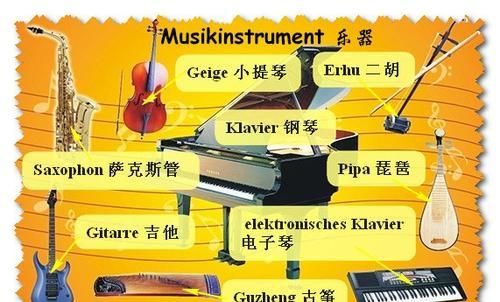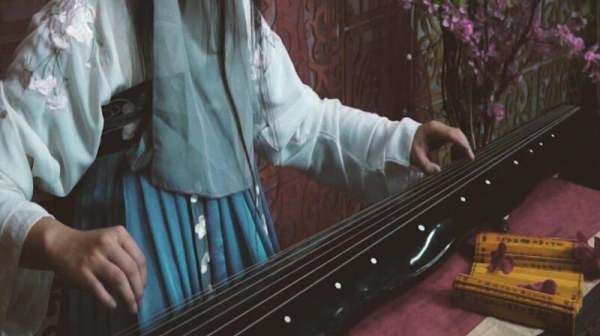本文目录
中国乐器的英文名称
drum
鼓
violin
小提琴viola
中提琴cello,violoncello
大提琴harp
竖琴
zither
齐特拉琴,九弦琴
lyre
里拉琴,七弦琴
chinese
lute,
琵琶
guitar
吉他lectricguitar
电吉他
sound
hole
音孔
so
nstrument木管乐器
pipe芦笛
bagpipes
风笛
clarinet
单簧管
horn,
trumpet
小号
cornet
军号,短号
trombone
低音号
saxophone
萨克管
pen
钢笔
pencil铅笔
pencil
box
文具盒
ruler尺子
ball球
football足球
basketball篮球
table
tennis乒乓球
tennis
网球
badminton
羽毛球
golf
高尔夫
handball
手球
water
polo
水球
ice
hockey
冰球
billiards
台球
baseball
棒球
够不?!!

中国传统乐器有哪些用英语翻译
CHINESE MUSICAL INSTRUMENTS
There are many deep traditions of the bowed, plucked, wind, and percussion instrument families, and many in these families of instruments are listed here below. These instruments are used for traditional music, classical music, folk music, and modern music and compositions (there are also many other older instruments used by the many Minority groups in China). (NOTE - all of the tunings listed in the bowed and plucked instruments are from the lowest pitched strings to the highest - and the word "qin" 琴 means "instrument"):
Bowed Instruments:
1.Erhu 二胡 - the Chinese two string violin with metal strings, tuned a fifth interval apart, to D and A, or sometimes to C and G. "Huqin" is the name for this family of Chinese bowed instruments; and "qin" is the general name for an instrument. It is called nanju (or the nanhu 南胡 ) by Cantonese and Taiwan people..
2.Jinghu 京胡 - the Beijing Opera two string violin pitched one octave above the erhu. The soundbox is made of bamboo and the strings are usually metal; traditionally the strings were silk, and silk strings are occasionally still used. The strings are tuned a fifth interval apart.
3.Gaohu 高胡 - the soprano version of the two string erhu, tuned a fourth interval higher than the erhu, with metal strings tuned a fifth interval apart.
4.Zhonghu 中胡 - the deeper "viola" version of the two string erhu, with metal strings tuned in fifth intervals; and tuned a fourth or a fifth lower than the erhu.
5.Gehu 革胡 - the deeper "cello" version of the two string erhu, with metal strings tuned a fifth interval apart. Bei gehu 倍革胡 is the big deeper "bass" with four metal strings tuned in fifth intervals.
6.Sihu 四胡 - an erhu type instrument with four silk strings tuned in fifth and fourth intervals, to C-G-C-G, or D-A-D-A. It sounds much like the human voice, and it has a bow which has two simultaneous bowing parts.
7.Dalei 大擂 - an erhu type instrument with the soundbox made of copper, tuned lower than the erhu, also sounding much like the human voice, with two metal strings tuned a fifth interval apart; traditionally they were tuned a fourth interval apart.
8.Banhu 板胡 - a loud erhu type instrument made of coconut, with two metal strings tuned in fifth intervals.
9.Nanju (or the Nanhu 南胡 ) - the Cantonese opera erhu, with two metal strings tuned a fifth interval apart.
10.Matouqin 马头琴 (or in Mongolian, the Morin Huur, the Morin Khuur, the Morin Xuur, the Morin Khor, or the Marinhur, or the Chaoer in eastern Mongolia), the Mongolian deep sounding two string bowed instrument that got its name from the carved horse head by the tuning pegs, with nylon or metal strings, and traditionally with horsehair strings, and they are tuned a fifth interval apart. There are three different sizes, like the Western violin, viola, and cello. Traditionally in eastern Mongolia the fingerboard is played normally like a violin, and the instrument is also called the Chaoer, but in western Mongolia, traditionally the string is played where the bottom of the nail meets the skin of the finger, so that the sound is produced with both the nail and the finger. Di Matouqin 低马头琴 - the bigger and lower pitched Matouqin, also tuned in fifth intervals.
Plucked Instruments:
1.Pipa 琵琶 - the four string Chinese fretted lute, with metal strings, and occasionally with silk strings. It is tuned G-C-D-G, or A-D-E-A.
2.Liuqin 柳琴 - the small pipa, the Chinese fretted lute, with three or four metal strings. It has either three strings tuned G-D-G, or four strings tuned G-D-G-D; and the four strings can also be tuned in fifths like a Western violin, to G-D-A-E.
3.Yueqin 月琴 - also called the "moon guitar", played with the Beijing Opera, a banjo-like fretted instrument with three or four metal strings. It is tuned A-D-A, or G-C-G, or D-A-D, or C-G-C; or with four strings, it is tuned D-A-D-A, or C-G-C-G.
4.Ruan 阮 - similar to the yueqin, but it has a hollow soundbox and a longer neck. It has three or four metal strings and is fretted. Xiaoruan 小阮 has three strings tuned D-A-D, or four strings tuned D-A-D-A. Zhongruan 中阮 , the medium lower ruan, has four metal strings tuned D-A-D-A, or to G-D-G-D; or tuned in fifth intervals like the Western cello to C-G-D-A, and it is fretted. Daruan 大阮, the big bass ruan, is traditionally tuned D-A-D-A, and in modern times it is also tuned in fifth intervals like the Western cello C-G-D-A, and it is usually bowed.
5.Sanxian 三弦 - the three string unfretted lute with metal, or gut, or nylon strings, with a long neck and made of snake skin. This instrument is also played in Japan, and it is also the main instrument for traditional music in Okinawa. It is tuned C-G-C.
6.Yangqin 扬琴 - the hammered dulcimer, called the "Butterfly Harp."
7.Guqin 古琴 - (or the qin), the ancient seven string Chinese zither with metal strings wrapped with nylon, played by sliding the fingernail up the strings. It originally had five strings, and was called the qin, meaning "instrument," or "stringed instrument"; and the term "gu" means ancient. The standard tuning (listed in the key of C) is G-A-C-D-E-G-A. Another very common tuning (for the key of F) is C-D-F-G-A-C-D, and there are many others.
8.Guzheng 古筝 (or the Gu-Zheng, or the Zheng, or the Cheng), the Chinese zither/ harp with 16 to 25 strings and a moveable bridge. The 18 string and the older 16 string ones have metal strings and the 21 to 25 string ones have wire strings wrapped with nylon. Traditionally the older instrument had 13 strings made of silk, and that one was the ancestor of the Japanese Koto. The two most common tunings are the C pentatonic scale (C-D-E-G-A), and the G pentatonic scale (G-A-B-D-E); the pentatonic scale has the first, second, third, fifth, and sixth degrees of the scale.
9.Konghou 箜篌 - the vertical guzheng, the Chinese zither/harp, somewhat like a Western harp, with four pedals, and it usually has five or six octaves. It has metal strings wrapped with nylon in the lower section, and the higher strings are sometimes metal.
10.Se 瑟 - the ancient 50 string zither with a moveable bridge, which is no longer played. It may have been the forerunner of the guzheng, the Chinese zither/ harp (see related article). It had silk strings.
11.Hudie Zheng 蝴蝶筝 - somewhat like two guzhengs combined, sometimes called the "butterfly guzheng", which is a recent invention, but rarely played. It has metal strings wrapped with nylon, and some of the high strings can be metal. It has a set of 25 strings tuned normally to a pentatonic scale on the right side (with the first, second, third, fifth, and sixth degrees of the scale - in the key of C those notes are C, D, E, G, and A), where the bridge is moveable; and on the left side of the bridge, with notes that cannot be bent (and without a moveable bridge), a set of strings is tuned in half steps to all twelve chromatic Western pitches within the octave; also the left side has some pairs of strings that are tuned to the same notes that correspond to the notes of the strings on the right side of the bridge that are in the pentatonic tuning.
12.Khomuz (or the Koxianqin 口弦琴) - the Mongolian jaw harp with one or two metal reeds, played by holding it in the mouth and changing the tones with the mouth cavity.
13.Duxianqin 独弦琴 - an old one string instrument with a metal string supported by a wood bow, played by plucking the string and bending the wood bow.
Wind Instruments:
1.Xun 埙(or the Huin, or the Hsuin, or the Hsun) - a clay wind instrument with eleven holes. It was revived by the Guzheng master Cao Zheng in the early 1970s, and it became very popular again in 1998.
2.Dizi 笛子 - the horizonal side-blown bamboo flute.
3.Xiao 箫 (or the Hsiao) - the vertical bamboo flute.
4.Paixiao 排箫 - Chinese pan-pipes.
5.Sheng 笙 - the bamboo mouth organ, blown both in and out. It was the ancient ancestor of the Western harmonica. Diyinsheng is the big mouth organ with 48 pipes.
6.Hulusi 葫芦丝 - made of bamboo or another plant such as straw grass, and played like a mouth organ, blown both in and out. Shuangguan Hulusi is the double-reed hulusi.
7.Bawu 巴乌 - the small and deeper sounding bamboo flute.
8.Guanzi 管子 - the short cylindrical-bore oboe type older flute, made of wood. Shuangguan 双管 is a double-pipe flute made of wood.
9.Suona 唢呐 - Chinese trumpet, further specialized into gaoyinsuona, the soprano trumpet; zhongyinsuona, the lower trumpet; and diyinsuona, the bass trumpet.
这样应该挺详细的吧,嘿嘿·

中国乐器的英文名字
Violin 小提琴
Viola 中提琴
Cello 大提琴
Double bass 低音提琴或大贝司
flute 长笛
piccolo 短笛
clarinet 单簧管
trumpet 小号
cornet 短号
trombone 长号
tuba 大号
organ 风琴
bass drum 大鼓
tambourine 铃鼓
琵琶lute
erhu:二胡
Gu Zheng:古筝
Harmonica:口琴
一、Woodwinds: 木管乐器
1.Piccolo 短笛
2.Flute 长笛
3.Soprano Recorder 高音竖笛
4.Oboe 双簧管
5.English Horn 英国管
6.Bassoon 大管
7.Contrabassoon 低音巴松
8.Clarinet in Eb 降E调单簧管(小黑管)
9.Clarinet in A A调单簧管
10.Clarinet in Bb 降B调单簧管
11.Bass Clarinet 低音单簧管
12.Soprano Saxophone 高音萨克斯
13.ALto Saxophone 中音萨克斯
14.Tenor Saxophone 次中音萨克斯
15.Baritone Saxophone 上低音萨克斯
16.Alto Flute 中音长笛*
17.Bass Flute 低音长笛
18.Oboe d' Amore 双簧管的一种
19.Piccolo Clarinet 高音单簧管*
20.Alto Clarinet 中音单簧管(Eb调的,属于低音单簧管)
21.Contrabass Clarinet 倍低音单簧管
22.Descant Recorder 高音竖笛
23.Alto Recorder 中音竖笛
24.Tenor Recorder 次中音竖笛
25.Bass Recorder 低音竖笛
26.Bagpipes 风笛
27.Basset Horn 巴赛管(单簧管)
28.Panpipes 排萧
二、Brass: 铜管乐器
1.Cornet 短号
2.Trumpet in Bb 降B调小号
3.Trumpet in C C调小号
4.Flugelhorn 夫吕号(行进乐队常用)
5.Horn in F F调圆号
6.Trombone 长号
7.Tenor Trombone 次中音长号
8.Bass Tromone 低音长号
9.Baritone(T.C.) 次中音号
10.Baritone 次中音
11.Euphonium 小低音号
12.Tuba 大号
13.Bass Tuba 低音大号
14.Piccolo Cornet 高音短号
15.Piccolo Trumpet in A A调高音小号
16.Bass Trumpet in C C调低音小号
17.Alto Trombone 中音长号
18.Contrabass Trombone 倍低音长号
三、Pitched Percussion: 有音高打击乐器
1.Timpani 定音鼓
2.Bells 排钟
3.Glockenspiel 钢片琴
4.Crystal Glasses
5.Xylophone 木琴
6.Vibraphone 颤音琴
7.Marimba 马林巴琴
8.Bass Marimba 低音马林巴琴
9.Tubular Bells 管钟
10.Chimes 钟琴
11.Steel Drums 钢鼓
12.Mallets 三角木琴
四、Percussion: 小打击乐器
1.Percussion 小打击乐器组
2.Wind Chimes
3.Bell Tree 音树
4.Triangle 三角铁
5.Crotales 响板
6.Finger Cymbals 手指小镲
7.Sleigh Bells 马铃
8.Cymbals 大镲
9.Cowbell 牛铃
10.Agogo Bells (由两个锥型铁筒组成,比牛玲音高)
11.Flexatone
12.Musical Saw 乐锯
13.Brake Drum 闸鼓
14.Tam Tam 大锣
15.Gong 锣
16.Claves 响棒
17.Slapstick 击板
18.VibraSlap
19.Sand Block 沙轮
20.Ratchet 齿轮剐响器
21.Guiro (木制,用铁棍剐)
22.Cuica (发出的声音象狗叫的拉丁乐器)
23.Maracas 沙槌
24.Castanets 响板
25.Wood Blocks 盒棒
26.Temple Blocks 木鱼
27.Log Drum 木鼓
28.Tambourine 铃鼓
29.Whistle 哨
30.Siren 汽笛
31.Jawbone
32.Anvil 乐钻
五、Drums: 鼓
1.Drum Set 架子鼓
2.Bongo Drums 邦加鼓(用手指敲的小鼓,夹在两腿间)
3.Timbales 蒂姆巴尔鼓
4.Conga Drums 康加鼓(橄榄型)
5.Snare Drum 小军鼓
6.Quad Toms 4组鼓筒鼓
7.Quint Toms 五组筒鼓
8.Tenor Drum 次高音鼓
9.Tom Toms 筒鼓
10.Roto Toms 轮鼓
11.Bass Drum 低音鼓
六、Plucked Strings: 弹拨乐
1.Harp 竖琴
2.Guitar 吉他
3.Scoustic Guitar
4.electric Guitar 电吉他
5.Banjo 班卓
6.Bass 贝司
7.Acoustic Bass 非电贝斯
8.Electric Bass 电贝司
9.String Bass 弦贝司
10.Mandolin 曼陀林
11.Lute 琉特琴
12.Ukulele 夏威夷四弦琴
13.Zither 齐特尔琴
14.Sitar 锡塔尔琴
七、Keybords: 键盘
1.Piano 钢琴
2.Organ 管风琴
3.Harpsichord 大键琴
4.Celesta 钢片琴
5.Accordion 手风琴
6.Clavichord 古钢琴
7.Harmonium 脚踏式风琴
8.Synthesizer 电子合成器
八、Chorus: 合唱
1.Soprano 女高
2.Soprano Ⅰ 女高1
3.Soprano Ⅱ 女高2
4.Mezzo-Soprano 女次高
5.Contralto 女低
6.Alto 女低
7.Counter-Tenor
8.Tenor 男高
9.Tenor Ⅰ 男高1
10.Tenor Ⅱ 男高2
11.Baritone 男中
12.Bass 男低
13.Bass Ⅰ 男低1
14.Bass Ⅱ 男低2
15.Voice 人声
16.Vocals 元音
九、Strings: 弦乐
1.Violin 小提琴
2.Violin Ⅰ 小提琴1
3.Violin Ⅱ 小提琴2
4.Viola 中提琴
5.Cello 大提琴
6.Violoncello 低音提琴
7.Contrabass 低音提琴
8.Double Bass 倍低音提琴
9.Solo Violin 独奏小提琴
10.Solo VIola 独奏中提琴
11.Solo Cello 独奏大提琴
12.Solo Bass 独奏低音提琴
13.Viola d' Amore
十、Handbells: 手铃
1.Handbells 手铃
2.Handbells(T.C) 手铃(中音)

中国传统乐器英文介绍ppt
1,古琴(Chinese zither)
The oldest plucked instrument in China has a history of more than 3,000 years.
(中国最古老的弹拨乐器,有三千多年的历史。)
Known as the first of the four arts, in ancient times is the highest status of Musical Instruments. Guqin is full of legendary symbolic colors.
(被誉为琴棋书画四艺之首,在古代是地位最崇高的乐器。古琴充满着传奇的象征色彩。)

2,瑟(Mr)
One of the original silk stringed Musical Instruments in China, it has 25 strings.
(中国原始的丝弦乐器之一,共有二十五根弦。)
After thousands of years of silence, "youlan han music" has once again presented the legendary voice on the stage.
(瑟曾销声匿迹千年之久,而今“幽兰汉乐”将传说中的声音再次呈现于舞台之上。)
3,箜篌(The harp)
The ancient stringed musical instrument in China started in the han dynasty and has a long history.
(中国古老的弹弦乐器,始于汉代,历史悠久。)
Wide range, soft and clear tone, strong expression.
(音域宽广、音色 柔美清澈,表现力强。)
In the tang dynasty, it was used in xiliang, qiuci, shule, koryo and tianzhu. It was lost for 300 years after the Ming dynasty.
(唐时期曾用于西凉、龟兹、疏勒、高丽、天竺诸乐中。明代后失传达300年之久。)
4,方响(The ring)
The ancient percussion instrument consists of sixteen rectangular jade pieces of the same size.
(古代打击乐器,由十六块大小相同的长方形玉片组成。)
With thickness different fixed tone high, points up and down two suspension, with a small hammer.
(以厚薄不同定音高,分上下两层悬挂,用小铁锤敲击。)
Appeared in the northern zhou dynasty. In the sui and tang dynasties, it was used in yan music and later in the court.
(出现于北周。隋唐时用于燕乐,后也用于宫廷雅乐,自宋代后渐少。)
5,八音(eight)
A kind of traditional Chinese instrumental wind and percussion music.
(中国传统器乐吹打乐的一种。)
It was the earliest scientific classification of Musical Instruments in Chinese history.
(原为中国历史上最早的乐器科学分类法。)
In the western zhou dynasty, the Musical Instruments were made according to their materials.
(西周时已将当时的乐器按制作材料。)
以上就是关于中国乐器及分类用英语怎么说 ,中国乐器的英文名称的全部内容,以及中国乐器及分类用英语怎么说 的相关内容,希望能够帮到您。
